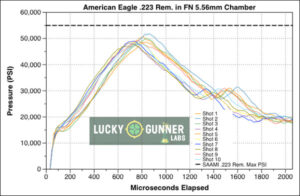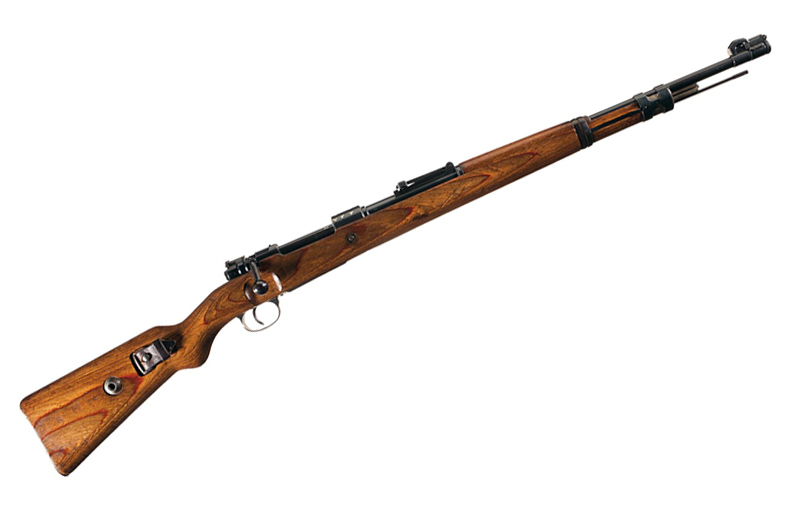It is rare that brilliant ideas are realized overnight. Nor is their significance always understood. A 1939 production K98k. Photo: Rock Island Auction Company. Paul Mauser revolutionized combat weapon technology in the late nineteenth century by creating what would become one of the most famous bolt-action rifle families ever made. Mauser’s first designs were created in the days when black powder cartridges were used. They evolved over time as smokeless powder and spire point bullets became available. His rifles were so reliable, safe, and accurate that he had a large number of countries arm themselves with Mauser rifles in the 19th and early 20th centuries. These included Argentina, Austria, Belgium Czechoslovakia El Salvador, Estonia Israel, Japan Latvia, Poland, Portugal Romania and Saudi Arabia. Spin a globe and stop it using your finger. If you count only military rifles, the country where your finger lands was likely armed with a Mauser Bolt-action rifle. Hunters have loved and used civilian sporter-style Mausers on every continent, even today. The first successful Mauser was the Model 1871. It was a single-shot bolt action chambered for a metallic-case 11,15×60 mm blackpowder cartridge. It had a wing-safety and the bolt was locked to the receiver bridge. In 1884, a repeater version improved with a tube magazine was introduced and named the 71/84. The Infanterie-Gewehr was renamed 71/84 by the German Empire. The Mauser Model 1887, a modified version of the rifle, was also made for Turkey. A Mauser Model 1871. Photo: Rock Island Auction Company.Mauser began to produce improved designs, with each successive model improving on the previous. In the early 1880s more powerful smokeless-powder cartridges quickly replaced black powder. Mauser designed two different variations of the same rifle for the German Rifle Test Commission (Gewehr-Prufungskommission), but these rifles were not ready for prime time due to the death of Paul Mauser’s brother, Wilhelm, who was the financier of the company. These two rifles were known as the 89 Belgian Mauser, and the 91 Argentine Mauser. The Mauser’s rate-of-fire was greatly increased by the ability to load its internal box magazine using a stripper clip. The claw extractor was introduced with the Model 92. The Spanish Mauser, or Mauser Model 1893, would receive the iconic controlled feeding action. This feature is now synonymous with Mauser. The claw extractor grips the cartridge rim before the round is stripped out of the magazine and into the chamber. The Karabiner 98k bolt with its controlled feeding action. The model 93 introduced a 5-round, staggered column, internal box magazine which could be reloaded by pushing a clip from the top receiver while the bolt was open. The 7x57mm cartridge, also known as the 7mm Mauser, was introduced. Sweden adopted the Model 94. The Model 1895 differed from the Model 1893 in that it used a cylindrical bolt face instead of the square bolt faces of the Model 93. The Model 1895 incorporated a shoulder in front of the bolt handle to provide additional locking if the bolt fails. Chile, China, Iran and Uruguay were among the countries that used it. In 1893, Sweden and Norway both adopted the new 6.5x55mm round, also known as the Swede 6.5mm, and Mauser chambered their Model 1896 rifles in this caliber. This Mauser design included gas-escapes holes and an integral guide on the bolt body. A Swedish Mauser. Photo: Rock Island Auction Company.By the year 1898, Mauser’s design had evolved into the Gewehr 98. This was the precursor to the most successful Mauser produced. The Gewehr 98, adopted by the German Army as early as 1898, was in service from 1935. It had an internal box-magazine that was fed from a 5-round stripper and the Mauser controlled feed action. It weighed nine pounds and had a barrel that was 29 inches long. The total length was 49.2 inch. The Gewhr 98 had a straight bolt that jutted at a 90-degree angle out on the right side. A Gewehr 98. Photo: Rock Island Auction Company. The Gewehr 98 is chambered for Patrone 88 or M/88. This is a rimless, bottleneck 8mm cartridge, and another first generation smokeless propellent. It was loaded with full metal jacket, round-nose bullets weighing 225 grains. The muzzle velocity was 2,034 fps. The maximum effective distance was approximately 550 yards. The German military used this round until 1904, when it was replaced with the S Patrone cartridge (also known by the names 7.92x57mm or 8x57mm). A Steyr K98k with bayonet. Photo: Rock Island Auction Company.The Karabiner 98k evolved out of the Gewehr 98. The name should give you a good idea about the rifle’s features. The gun was called a Karabiner, not a Gewehr. The “k” suffix stands for “kurz”, which means short. The Karabiner 98k is also known as the Kar98k or 98k. It was adopted as the standard service rifle by the German Wehrmacht in 1935. It featured a shorter barrel of 23.6 inches, a controlled feed action, and a 5-round magazine that was loaded using stripper clips. The action was simplified, and only 29 parts were used. Gewehr 98s, on the other hand, had 44 parts. The bolt handle was also lowered to allow for rapid operation. It also allowed mounting an optical on the receiver. It has a 90-degree lift and two locking lugs which mate in the receiver at 12 and 6 o’clock. The controlled feed action is a non-rotating extraction that grabs the cartridge by its rim during loading and unloading. The receiver was made from steel forgings, which were then machining. Karabiner 98k disassembled. The three-position manual safety system was also easy to use. It could be flicked left to fire, straight-up to prevent firing while allowing the bolt to still be manipulated, and to the right for locking both the firing pin as well as the bolt. The middle position was used as a dashboard dumb light, as it blocked the sights and informed the user to switch to safe or fire. The safety was placed in a way that it could be easily operated by the thumb of the firing hand. On the K98k, the Langevisier (rollercoaster rear sight) of the Gewehr98 was replaced by a tangent-leaf sight. The new sight was flatter, and did not block the view to the sides as did the older sight. In 1939, the front-post sight was incorporated with a hood to reduce glare. The early Karabiner 98k rifles were made with a single-piece wood stock, but from 1937 onwards, they used a laminated beech wood stock, which was stronger, less likely to warp, and cheaper to produce than hardwood. The stock featured a steel plate and a metal disk attached to the side that was used to disassemble bolt. Its simplicity, strength and accuracy made it a brilliant rifle. It was eventually produced in 14.6 million K98ks. The Second World War began in 1939 – just four years after the adoption of the Mauser – and yet, all branches of the German army were equipped with the latest Mauser rifles when the time came to use them. The M/88 round that was used in the Gewehr98 was the first-generation smokeless-powder cartridge, and it did not benefit from the newer spire point bullets. The German military created the S Patrone in order to take advantage of the new developments made in bullet shape and smokeless cartridges. The “S” is the German word for spire-point bullet, and “Patrone”, “cartridge”. Two 8mm Mauser cartridges: Patrone 88 (left), vs. S Patrone. Photo: Wikipedia. The bores of Karabiner 98k guns were also redesigned in order to be more compatible for the new 7.92x57mm cartridge. The S Patrone bullet was.323 inch in diameter, while the M/88 bullet was only.318 inch. The S Patrone cartridge was phased out by 1933 and replaced by the s.S. Patrone. This cartridge was originally used in long-range machine guns for WWI. It was loaded with 198-grain full metal jacket bullets that were heavy, pointed and full metal jacket. This round produced less flash from the shorter barrel Karabiner98k than the S Patron and had a better ballistic performance during WWII than most other rifle rounds. The K98k produced a muzzle speed of 2,493 fps, and the bullet was able to penetrate 33 inches of pine wood at 109 yard. The S.m.E. was developed in 1940 because lead was scarce in Germany. In 1940, a round with a spitzer bullet weighing 178 grains and a mild steel core was developed. A K98k loaded with an 8mm Mauser stripper clip. Photo: Wikipedia.Mauser didn’t produce all 14.6 million Karabiner-98k rifles produced, as the surge of production from 1934 to 1944 required other manufacturers to contribute. The receivers were stamped using a numerical code that indicated the date and place of manufacture. The numeric codes were changed to letter codes in 1937. The receiver markings on a K98k. The “337”, indicates that it was manufactured at Gustloff Werke. Photo: Wikipedia/Auckland Museum. Other manufacturers include Erfurter Maschinen-und Werkzeugfabrik (ERMA) (27 – ax), Sauer & Sohn 147 – ce, Berlin-Lubecker Maschinenfabrik 237 – duv, Gustloff Werke 337 – bcd), Steyr-Daimler-Puch 660 – Enz and Waffenwerke Brünn 945 – swp45 – dot These factories were located mainly in Germany, but also in some occupied areas. Born for BattleThe Karabiner 98k was used by the German military across all theaters of war: Europe, North Africa and the Soviet Union. Finland and Norway. The K98k was used by the German military to fight against other bolt-action weapons that fired slowly, such as the British Lee-Enfield or the Soviet Mosin-Nagant. The Mauser, with its 5-round magazine, was at a disadvantage compared with the faster-shooting Lee-Enfield’s 10-round magazine. However, it managed to hold its ground. When compared to semiautomatics such as the M1 Garand it was clearly outmatched. Two SS soldiers with a K98k slung over their backs. The K98k wasn’t updated during World War II, but was simplified and lowered in price to reduce production costs and speed. The Kriegsmodell variations were not improvements, but rather steps backwards. The captured K98k rifles became a valuable commodity to non-Germans. They were used by all resistance and partisan groups that could obtain them. Due to a shortage of small arms early in the war, the Soviet Army also used captured Kar98ks. Zeiss Zielvier telescopic sights (ZF39) were fitted to rifles that had been exceptionally accurate in factory testing. This gave the rifles an effective range of more than 1,000 yards. Optics from Ajack, Hensoldt and Kahles were also used, as well as those manufactured by Opticotechna Dialytan, Hensoldt and Ajack. A German soldier with a sniper version Karabiner 98k.A designated Marksman variant, known as the K98ks, was also developed. This was equipped with a 1.5x Zf 41 scope. The scope was mounted on the rifle in a scout-rifle style, with a long eye-relief, and it was attached to the receiver via a quick-detach mechanism. Other wartime variations included experimental designs, such as paratrooper versions and a.22 caliber training version, known as the KKW cadet gun. The USSR would supply these rifles, along with other captured German and Soviet weapons, to allied governments during the Korean and Vietnam Wars where they would once again be used against Americans. The K98k was used by many countries after Nazi Germany was defeated. From East to West Germany to Yugoslavia and Israel. Zastava, a Yugoslavian weapons maker, refurbished German Karabiner 98k guns to fill the gap. These rifles are easily identified by the Yugoslavian Communist Party crest and the “/48”, which was added to the original “Mod.98” designation stamped on the receiver. Austria converted surplus K98k rifles to sniper rifles, naming them the SSG 98k in 1958. The SSG 98k was rechambered to 7.62x51mm NATO and fitted with Kahles ZF58 4×41 optical systems. Photo: User “Absolut” on the TheK98kforum.Collecting Mauser RiflesThe glory days of collecting inexpensive Mausers have gone the way of the rotary dial phone. The only ones for sale are either in a very poor condition or extremely expensive. In 2023, a Karabiner in NRA-good condition will cost more than $1,000. A well-used Karabiner 98k with a dented or pitted stock, which might be suitable as a weekend shooter, or wall hanger will cost between $500 and $700. A Yugoslavian K48 is an affordable option for those who want a replica of a K98k but don’t care where it was made. The Mauser LegacyPhoto: Wikipedia.The Karabiner 98k owes it’s stature as the most advanced combat bolt-action rifle to all Mauser rifles before it. This took a lot R&D. By the end of WWII, bolt-action weapons were no longer used by infantry. The K98k has survived in combat for longer than expected thanks to its massive production. It is still being used today and will likely continue into the future. Mauser’s legacy continues to live on, even if it’s mainly in the hands non-state actors.More classic military firearms:NEXT: Download Your Free Storm Tactical Printing Target Pack62 Printable MOA targets with DOT drills – Rifle range in YARDSThis impressive pack from our friends at Storm Tactical includes62 printable targets for rifle and handgun ranges. The target grids and bullseyes are measured in MOA. Subscribe to the Gun Digest newsletter and we will send you your print-at home target pack immediately. Enter your email below.

. 223 Rem vs. 5. 56x45mm NATO — Major Information You Need to Know
The . 223 Remington and its measurement suit, the 5. 56x45mm, are reportedly the most popular centerfire rifle round in the Western Hemisphere on June 20, 2025. Although” . 223
















